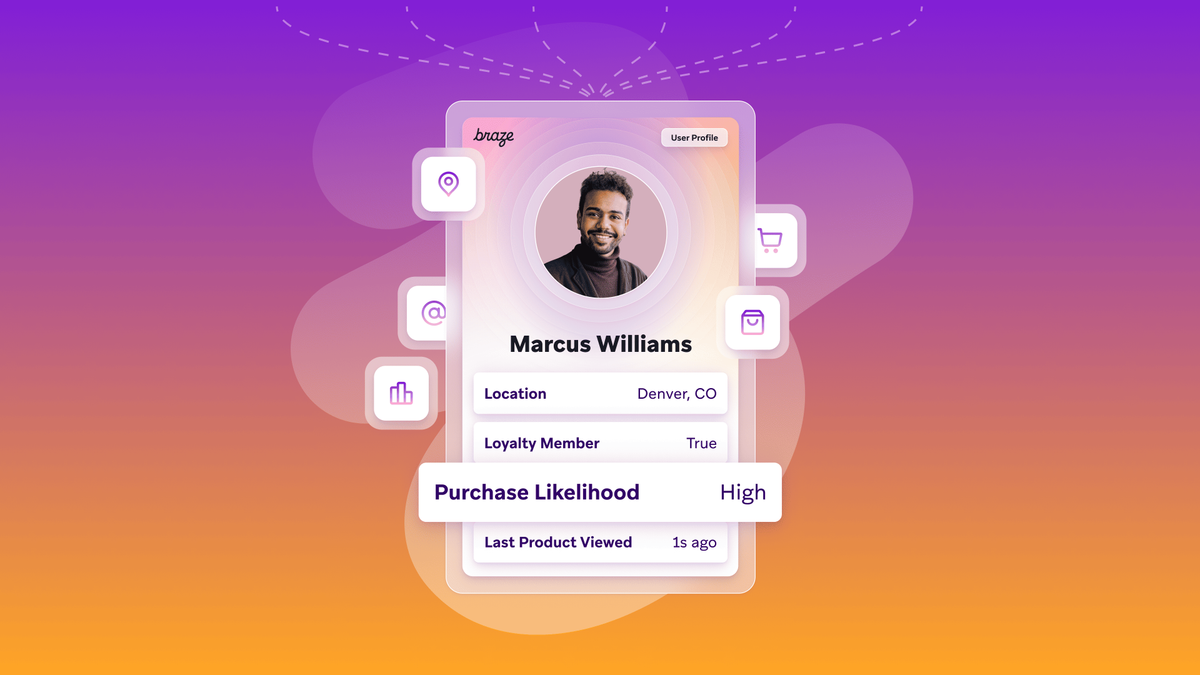Email Marketing: The Messaging Metrics That Matter
Published on February 22, 2023/Last edited on February 22, 2023/7 min read


Team Braze
Email—it's the original customer engagement channel. Before mobile messaging or even SMS, email was being used by marketers to blaze a trail when it came to building direct relationships with their customers. And while the marketing landscape has shifted in so many ways in recent years, the power and reach of email remains undiminished, allowing brands to communicate with their customers across desktop, mobile, and beyond.
But while marketers all over the world are using email to help power their customer engagement strategy, making the most of this key channel requires brands to assess its impact in meaningful ways. So whether you’ve been leaning on email marketing for years or are just starting out, knowing what email engagement metrics to pay attention to is crucial to ensuring long-term success. Here are five key email metrics to watch:
1. Non-Open Rates
Back in the day, email open rates—that is, the percentage of email recipients who open a given email—were one of the main ways that brands assessed the appeal and impact of their messaging campaigns in this channel.

However, the launch of Apple’s Mail Privacy Protection (MPP) feature in 2021 has complicated the usefulness of this metric by significantly inflating the number of email opens that marketers will generally see from each campaign. Accordingly, email opens are best leveraged by marketers today as a sort of negative KPI; that is, since it’s increasingly difficult to know how seriously to take an email open as a stat, you should look instead at how many of the people you sent a given campaign to DIDN’T open that email. That so-called “non-open” rate can be used to get a directional indicator of the comparative reach of different email campaigns you send, setting the stage for deeper investigation using more meaningful metrics.
2. Email Click Rates
For marketers looking to move past email opens while still getting a top-level look at channel performance, focusing on email click rates can be a smart way to make that happen.

In essence, clicks occur when an email recipient takes action by clicking a link within the message they receive—which means that, unlike email opens, this metric hasn’t been inflated by MPP and can be used to get a clear picture of the level of engagement that each email is seeing. However, there will likely be some natural variation when it comes to click rate (e.g. an email newsletter with a number of strong CTAs will probably have a higher click rate than a transactional email that isn’t intended to nudge the recipient to take any specific action), so be thoughtful about how you’re leveraging the metric as part of your overall performance assessment efforts; after all, you wouldn’t want to cut down on emails that were never intended to drive clicks just because they (surprise) didn’t drive clicks.
3. Email Bounce Rates
Both email open and click rates use the number of delivered emails as a baseline to assess the impact of a given campaign or email program—but what about the emails that don’t end up reaching their intended recipients? To understand how many of your emails are actually making it through the people you’re trying to reach, it’s important to keep an eye on your bounce rate, which comes in two distinct flavors: Hard and soft bounces.

Hard bounces are an essential tool for marketers looking to understand why their email campaigns aren’t having the reach they expect. Because these sorts of undelivered messages are associated with invalid or nonexistent email addresses, a high hard bounce rate is often a strong sign that the company in question is dealing with issues related to email list hygiene. If you find yourself dealing with a higher than expected hard bounce rate, take the time to look at your email list, how often it’s being cleaned up, and what your email sunsetting policies are like. The more you do to keep your lists clean, the more accurately you can predict what sort of bounce rates you’ll see and, in turn, how much impact your email campaign will have.

But while hard bounces are important, they’re not the only email bounces you’ll want to keep an eye on. Soft bounces are bounces triggered not by inactive addresses, but by temporary issues that prevent delivery—for instance, an overly full inbox, an email server that goes down, or a message that’s just too big for a given recipient’s inbox. For that reason, soft bounces are usually not as concerning as hard bounces when it comes to email list health, but they do provide useful insight into how many messages aren’t making it through and why, allowing you to better predict how much of an effect your email campaigns will have.
4. Email Complaint Rates
Unlike some other messaging channels (for instance, push notifications), email provides consumers with a number of different ways to register that they’re not interested in receiving future outreach. And while some users will choose to unsubscribe from an email mailing list after getting messages they don’t care for, many will instead choose to mark the message as spam.
When a user submits an email complaint (by marking a message as spam), it doesn’t just increase the risks that future messages sent to that individual end up in their junk folder; it also has the potential to damage your overall email reputation, potentially impacting your ability to ensure that your email is delivered even to highly engaged recipients who very much do want to see the messages you send. For that reason, keeping an eye on your email complaint rate can give you essential information about potential risks to the long-term health of your email program.

You can determine your email complaint rate by dividing the number of complaints by the number of emails delivered—and, as a general rule, if you’re seeing more than one complaint for every 1,000 emails you send, that’s a very serious warning sign that you’ve got a problem. To avoid that, consider creating a segment in your email marketing solution or customer engagement platform that contains individuals who have submitted email complaints; that way, you can easily get a picture of what percentage of your audience has major issues with your email program.
5. Email Conversion Rates
While some emails are purely informational in nature, most of the time that a marketing team sends members of their user base an email campaign, they’re doing it for a reason. Maybe they want the recipients to visit their app, or to make a purchase, or to refer a friend. But whatever that action is, understanding if the message in question motivated recipients to actually take that action is an essential part of assessing and optimizing your email marketing program. Accordingly, tracking your email conversion rate allows you to understand how successfully the messages you send are helping to support the central goal of a given campaign and hopefully send even more effective messages in the future.

To get an accurate picture of your email conversions, it’s essential that you set a conversion goal for each and every push campaign you send. As a general rule, customer messaging efforts are most effective when there's one strong call-to-action (CTA) as opposed to many competing options. However, many brands neglect to identify what their central goal is, making it impossible to track how successful they are at meeting it. By prioritizing setting a clear action for users to take and assessing how successfully you’re nudging them to take it, you can better understand which emails are really moving the needle for your business and which ones need to be reworked or sunsetted.
Final Thoughts
Now that you have a picture of what key metrics to watch in order to better understand the strengths and weaknesses of your email marketing program, the next step is to explore how you can optimize your use of the channel to drive more value for your customers and your brand. To learn more about what it takes to build a successful email campaign, check out the Braze Email Marketing Guide.



